|
2006 "Top Ten" Birding Experiences
List
2006 was a splendid year for me in
terms of nature photography and birding. I
was fortunate to visit
many of the best spots in the nation and managed to
have quite a
time! At the urging of a friend, Kris Purdy, I have created a top
ten list of my best birding experiences from 2006. I hope that you
enjoy some
of these stories, and I'll try to match them in 2007!
10. January 22, 2006 - Feeding
Frenzy - Ding Darling
National Wildlife Refuge - South Florida
Many photographers were reporting that
Ding Darling was a disappointment and that I shouldn't expect any of
the large feeding frenzies that were common in years past. I decided
to continue with my planned trip, but lowered my expectations
accordingly. Just a few hundred yards down the refuge loop road I
got out of my car to marvel at three Roseate spoonbill preening in
the dawn light. Yet something drew me to travel further into the
refuge. With all the other photographers paused at the first three
spoonbills I moved on and came across a site that I will never
forget. There in a shallow bay of salt water were dozens and
dozens...hundreds in fact...of herons, egret, ibis, sandpipers, and
spoonbills. The scene was one of constant motion and photographing
any single bird was difficult. In hindsight I sure wish that I I had
snapped more than a single shot of the assemblage (there are many,
many birds on back into the distance). Still I smile just thinking
about the commotion that fine January morning.

9. June 3, 2006 - Mangrove Cuckoo - Key Largo,
Florida
Fully-covered with clothing from head to toe I went
for a hike on a steamy summer morning in South Florida. Near Key Largo,
I was making my second trek into an impressive hammock to search
for a Mangrove Cuckoo. The morning
started off with a bit of a surprise as the first bird I heard was a Yellow-billed Cuckoo. I walked farther along the trail and
was soon treated with the characteristic call of my real quarry. I chased that
sound along several trails only to find that the bird had always melted
into the foliage. Finally with the 5th or 6th set of calls I spotted
movement in the top of a tree 40 yards away and swung my binoculars
into action. I instantly knew what I was seeing...and then the
Mangrove Cuckoo sealed the deal by calling for me while I watched
its throat puff up and down. The bird was too far way for a decent
photograph, so I simply watched it with binoculars until it dropped
back into the trees. Then it was time to get away from the
mosquitoes!!
8. August 20, 2006 - Ruby-throated
Hummingbird - Konza Prairie,
Kansas
It was mid-August and I was back in
Kansas after nearly a year in Florida. I returned to a prime patch
of trumpet vine on the Konza Prairie preserve and found it watched
closely by a half-dozen female and young male Ruby-throated
Hummingbirds. While keeping an eye on me they soon began to feed on
the blooms that were several feet away. These delicate little birds
would go all in on a trumpet flower bloom...often perching on the
flowers and making them droop slightly. One even came out from a
nectar dive with a few proudly ruffled feathers on the top of her
head.
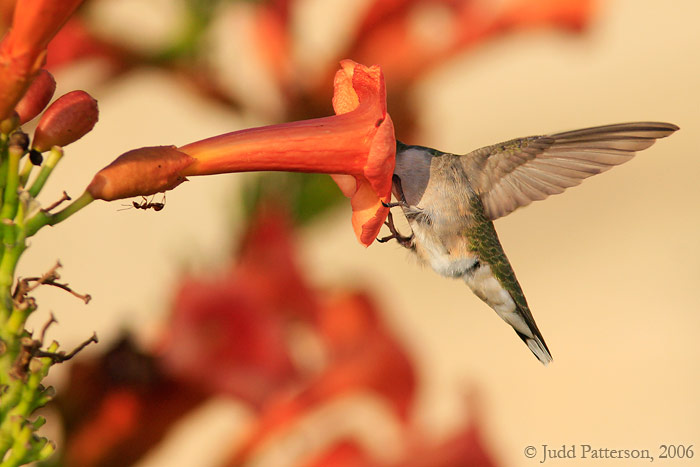
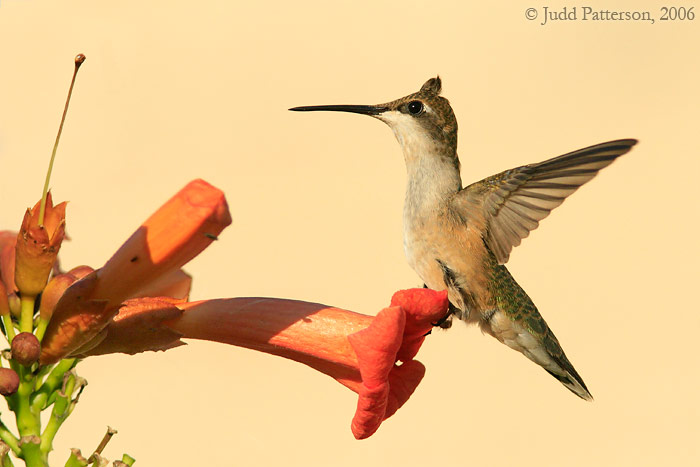
7. April , 2006 - Short-eared Owl
- Dry Tortugas
National Park, Florida
As I prepared for my journey to the
birding mecca that is Dry Tortugas National Park, I read account
after account of the species that I could expect. One bird that
struck a chord with me was the Caribbean race of the
Short-eared Owl. Perhaps it is simply my fascination with owls, but I
was extremely hopeful that I would find such a bird. A few days into
my journey Larry Manfredi told me that one was spotted on nearby
(but out of reach) Loggerhead Key. I now had to hope that it would make a visit
to Fort Jefferson before I left. My hopes were fulfilled that very
evening when one perched high in a buttonwood for all to see. The
next day I found it hunkered down in some grasses and was able to
get a few photographs.

6. October 14, 2006 - Fort DeSoto Park, Florida
I was in Tampa for a conference, and
there was no way that I could leave before visiting my favorite west
coast location in Florida...Fort DeSoto Park. I went in hoping that
I could get a good Piping Plover
photograph and see a lifer Red Knot. Wish one came true many
times over as I lay in inch-deep water and just let the plovers come
to me. I had several Piping Plovers all around me and sometimes
within 5 feet. Just before packing it in, I saw a strange bird that I
couldn't immediately identify. It was a winter plumage Red Knot and
I got off a couple photographs before it flew for a new stretch of
beach! Complete success...now I could fly home to Kansas!
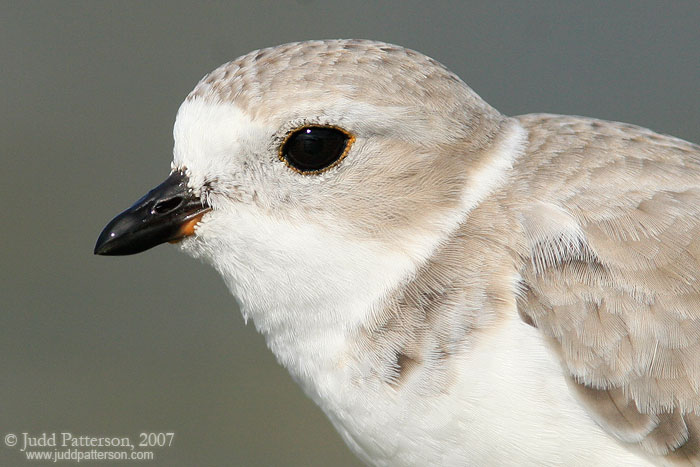
5. September 24, 2006 - Vermilion Flycatcher - Washington county, Kansas
Sometimes you don't have time for a
birding trip, but you go along anyway. With a report that a male
Vermilion Flycatcher was being seen about an hour north of my
location in Kansas (quite rare), I made the necessary sacrifices to
free up a little time. The bird was still there when
David Seibel and I arrived. The
flycatcher was a gorgeous bird and stunning in the golden light of
dawn. He eventually cooperated for a few photographs...he was only
seen for a couple more days.
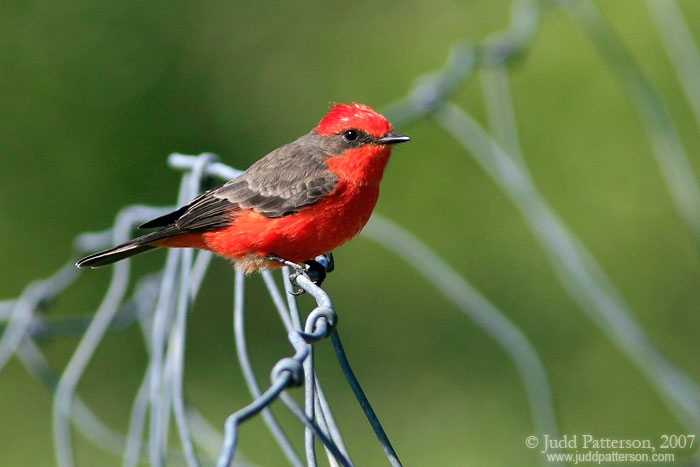
4. May 10, 2006 - Bananquit - St. Croix, U.S. Virgin Islands
Many who have looked long and hard at
their U.S. bird guide have probably seen a reference to a rare visitor...the Bananaquit. The
name alone is enough to conjure up visions of strange birds in
strange places. From that mysterious footnote in my bird guide the
Bananaquit emerged into reality when I visited the island of St.
Croix in the U.S. Virgin Islands. I saw not one, but a whole bunch
of Bananquits! Some would engage in nectar-robbing like the individual in the photograph below.
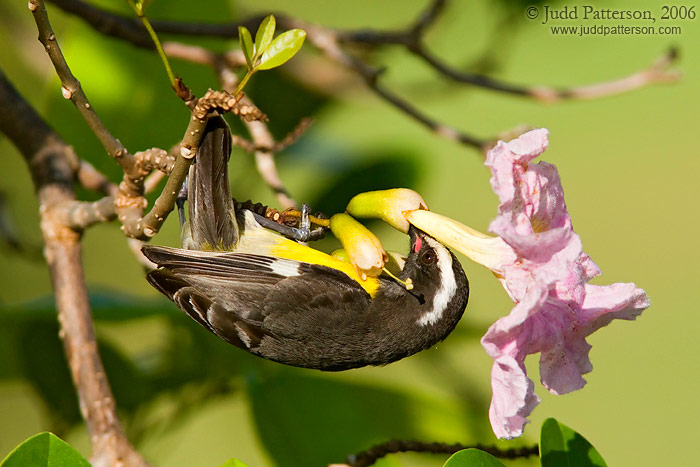
3. April 13, 2006 - Magnificent Frigatebird Colony - Dry Tortugas National Park
I still remember pulling into Garden
Key and seeing several magnificent Magnificent Frigatebirds hovering
effortlessly over Fort Jefferson. These seven-foot black and white
"kites" were clearly in charge of this airspace. The next day the
research crew and I headed over to Long Key and began to set up
Roseate Tern decoys (a species that hadn't nested in the area for
several years). A bunch of scraggly trees and branches that had
survived a quadruple hurricane hit in 2005 were just a hundred
meters away and in those trees was a busy frigatebird nesting
colony. With our decoys deployed I wandered around to the southeast
end of
the colony and positioned myself to watch in bright light as birds
swirled around in small circles while others remained perched. It
was absolutely astounding to see so many huge birds and to be so
close. There were males with their red throat sacks inflated, there
were females, there were juveniles, and even some chicks nearly
ready to leave the nest. I will never forget that experience.
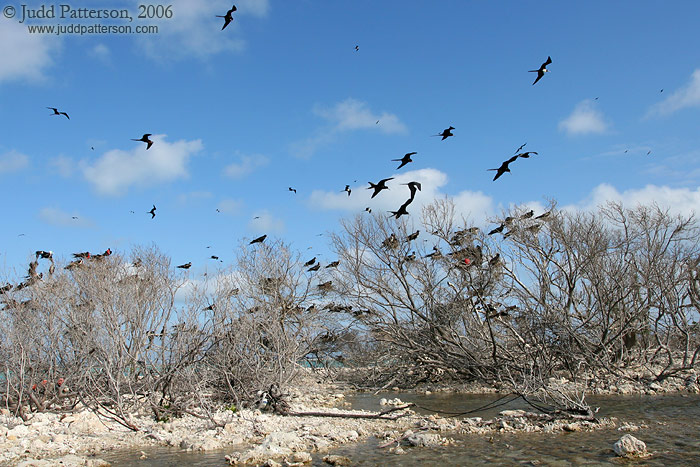
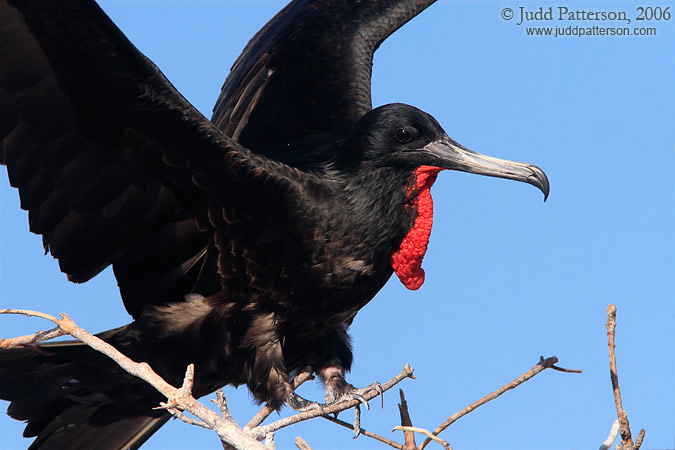
2. April 16, 2006 - Masked Booby
colony - Dry Tortugas
National Park
Sloshing across the slippery rocks
with my camera bag held aloft over my head, I felt a bit like
Robinson Crusoe as I ventured onto the soft sand beach. After
several aborted attempts to land in our small boat, we had decided
to try and walk onto Hospital Key in Dry Tortugas National
Park. Our principle mission as National Park Service staff (and I an intern) was to
replace "Island Closed" signs that had been blown away by one of
several hurricanes in 2005. We were all quite pleased to be
assigned this chore...for this is the only nesting location in the
continental United States for Masked Boobies. I counted over 30 active
nests, had many birds circling overhead, and glimpsed a couple tiny
chicks peaking out from under their mothers feathers.
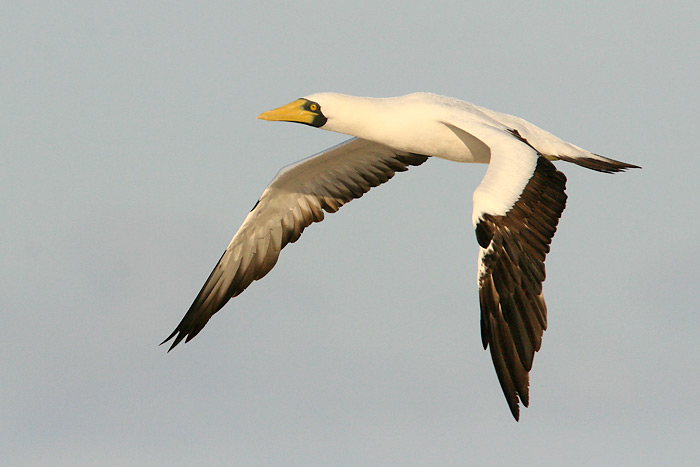
1. June 28, 2006 - Pileated
Woodpecker family - Banff National Park, Alberta
An investigation of movement to my right took my breath away. A
male Pileated Woodpecker had flown into a stump not more than 50
feet away and was rapidly hammering away at the rotting wood. Things
got better when he was joined by his mate...even
better when a few minutes later I found the reason for their busy
movements: an aspen tree nesthole with three hungry (and noisy)
chicks inside! This was my first good look at a Pileated Woodpecker
and I studied every detail. I only wish that the light hadn't faded
so fast or I could have shown photographs of a stump that was
absolutely obliterated by the male and female working in tandem to
feed the kids!
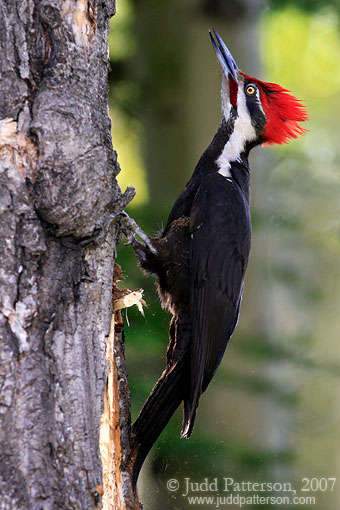
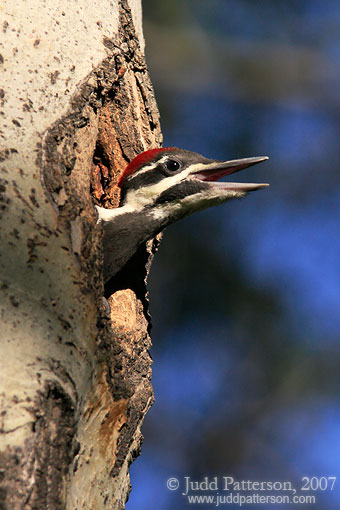
Best of birding and photography to all in
2007!
Spotlight Archive
|